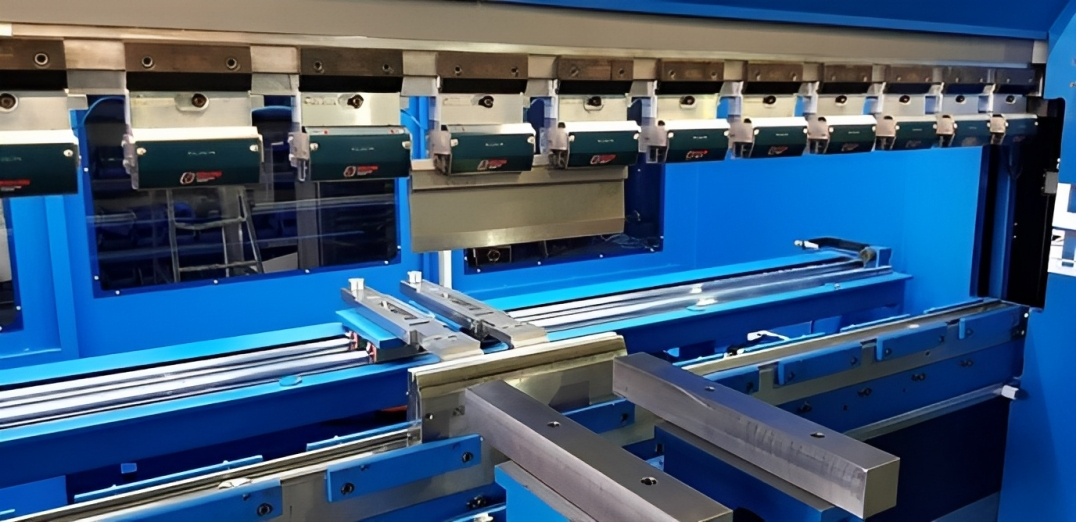What are the Key Innovations in CNC Press Brake Machine Technology?
- 1 The Evolution of CNC Hydraulic Press Brake Machines
- 2 Key Innovations in CNC Press Brake Machine Technology
- 2.1 Advanced Control Systems
- 2.2 Automated Tool Changeovers
- 2.3 Offline Programming and Simulation
- 2.4 Adaptive Bending
- 2.5 Electric Drive Systems
- 2.6 Integration of AI and Machine Learning
- 3 Benefits and Implications
- 4 Challenges and Future Prospects
- 5 Final Words
Precision and efficiency are crucial in the dynamic world of production. The CNC hydraulic press brake machine is one of the main actors in attaining these objectives. This technology has transformed metal manufacturing operations across industries because it can bend and shape metal sheets with exceptional precision and consistency. CNC press brake machines have significantly improved over time, resulting in higher output, less downtime, and better overall quality.
In this article, we will delve into the key innovations that have shaped the landscape of CNC press brake machine technology.
The Evolution of CNC Hydraulic Press Brake Machines
CNC hydraulic press brake machines, powered by computer numerical control (CNC) technology, have come a long way since their inception. Initially, press brake machines needed manual adjustments and calculations, which added time and risk of human mistake to the operation. By enabling precise control over the bending process, CNC technology altered this paradigm and increased precision and reproducibility.
Key Innovations in CNC Press Brake Machine Technology
Advanced Control Systems
Modern CNC hydraulic press brakes include cutting-edge control systems that provide unmatched accuracy and versatility. Instead of requiring human adjustments, these systems let operators to set the necessary bending angles, depths, and sequences. The programming procedure is made simpler by the use of touchscreens and user-friendly interfaces, which also lowers the learning curve for new operators.
Automated Tool Changeovers
Press brake operations have typically required lengthy tooling setups. However, more recent inventions have brought in automatic tool-switching systems. These technologies make it possible to switch between various tooling configurations quickly and seamlessly, reducing downtime and raising overall productivity. Manufacturers can handle a larger range of activities and effectively fulfill demanding production schedules by cutting setup time.
Offline Programming and Simulation
The development of simulation software and offline programming has revolutionized CNC press brake technology. Before implementing bending programs on the real machine, manufacturers may now design and refine them in a virtual environment. This not only increases productivity but also lowers the chance of mistakes and accidents. Operators may see every step of the bending process, making sure the finished product adheres to the required requirements.
Adaptive Bending
Press brake innovation has advanced significantly with adaptive bending technology. Based on input from sensors and cameras, this technology modifies the bending process in real time. Even when working with variances in material qualities or thicknesses, the machine can provide correct results by continually measuring the metal’s deformation during bending.
Electric Drive Systems
Electric drive systems have become more popular because of their energy economy and accuracy, replacing the hydraulic systems that have historically driven press brake equipment. Electric press brakes provide more immediate control over the bending process and do away with the need for hydraulic fluids. In line with current environmental and operational efficiency objectives, this technology also helps to make operations quieter and need less maintenance.
Integration of AI and Machine Learning
For CNC hydraulic press brake machines, the fusion of artificial intelligence (AI) and machine learning algorithms has created new opportunities. These systems may forecast maintenance requirements, advise the best tooling and bending settings for a given task, and improve bending operations by analyzing past data. This data-driven strategy optimizes equipment uptime, minimizes waste, and improves decision-making.
Benefits and Implications
Manufacturers and the metal fabrication sector as a whole would profit greatly from advancements in CNC press brake machine technology. These developments result in:
- Enhanced Efficiency: Automated procedures, speedier tool swaps, and offline programming considerably minimize production downtime, leading to higher throughput and enhanced productivity.
- Superior Precision: By incorporating cutting-edge control systems, adaptive bending, and AI-driven optimization, the finished products are produced with the utmost precision and with the fewest possible variations.
- Reduced Material Waste: Accurate control over the bending process combined with data-driven insights results in decreased material waste, which helps to save money and is more environmentally friendly.
- Expanded Capabilities: CNC hydraulic press brake machines are capable of working with a broader variety of materials, thicknesses, and intricate geometries, enabling producers to take on a wider range of projects.
- Skilled Workforce Transformation: The technology’s user-friendly interfaces and offline programming decrease the need for highly qualified operators, making it simpler to educate new employees.
Challenges and Future Prospects
While the advancements in CNC press brake technology have many advantages, they also have drawbacks. The initial cost of sophisticated equipment and training may be high. Additionally, to protect sensitive data, the integration of AI and machine learning calls for rigorous data management and cybersecurity measures.
Future prospects for CNC hydraulic press brake machines are quite promising. Even smarter and more autonomous devices may become possible with further progress in AI and machine learning. Incorporating IoT (Internet of Things) technology might also make it possible for remote diagnostics and real-time monitoring, improving maintenance procedures and reducing downtime.
Final Words
A new age of accuracy and efficiency in metal production has been ushered in by advancements in CNC press brake machine technology, notably in the field of CNC hydraulic press brake machines. The way manufacturers handle bending operations has changed as a result of these developments, which range from sophisticated control systems to AI-driven optimization. The advantages, such as improved efficiency, higher accuracy, and less waste, are what are causing these technologies to be widely adopted across sectors. The future of CNC press brake machines offers the possibility of even more astounding improvements as problems are solved and technology develops, further strengthening their position as a pillar of contemporary industry.





















